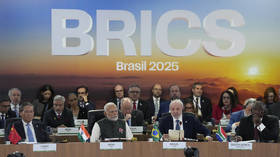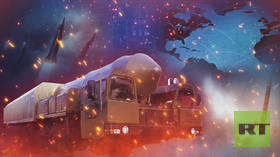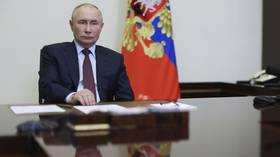russia today - 7/11/2025 11:01:51 PM - GMT (+3 )
A multipolar world is, by its nature, a nuclear one. Its conflicts are increasingly shaped by the presence of nuclear weapons. Some of these wars, such as the conflict in Ukraine, are fought indirectly. Others, as in South Asia, unfold in more direct forms. In the Middle East, one nuclear power has attempted to preempt another state’s potential development of nuclear weapons, backed by an even more powerful nuclear-armed ally. Meanwhile, rising tensions in East Asia and the Western Pacific bring the risk of a direct clash between nuclear states ever closer.
Having avoided a nuclear catastrophe during the Cold War, some European countries have since lost the sense of caution once associated with possessing such weapons. There are several reasons for this. During the ‘mature’ Cold War years, especially after the 1962 Cuban Missile Crisis, nuclear weapons played their intended role: they deterred and intimidated. Both NATO and the Warsaw Pact operated on the assumption that any large-scale confrontation would escalate into a nuclear conflict. Recognizing this danger, the political leaderships in Washington and Moscow worked to avoid the unthinkable.
Notably, while the Americans entertained the idea of a limited nuclear war confined to Europe, Soviet strategists remained deeply skeptical. During decades of Soviet-American confrontation, all military conflicts occurred far from Europe and outside the core security interests of the two powers.
Now, 35 years after the Cold War ended, the physical potential for global annihilation remains, but the fear that once restrained leaders has diminished. The ideological rigidity of that era has vanished, replaced by a less defined conflict between globalist ambitions and national interests. The world remains interconnected, but divisions increasingly run within societies rather than strictly between states.
The United States, the would-be global hegemon, has failed to build a stable international order. What we have instead is a historically ‘normal’ world: a world of great-power rivalry and regional conflicts. As always, shifts in power dynamics bring confrontation. And as ever, force is used to correct imbalances.
This new normal is one in which nuclear weapons remain potent, but seemingly remote. The threat of annihilation is veiled, no longer present in the public mind. Instead, wars are fought with conventional weapons, while nuclear arms sit unused, bound by an unspoken taboo. Few seriously consider using them, because any logical assessment shows that doing so would destroy what one is seeking to protect.
But the problem is this: conventional warfare can still destroy entire states. And countries that possess powerful conventional forces alongside nuclear weapons may be tempted to separate the two. In this context, any state facing an existential threat – even from conventional weapons – cannot be expected to forgo its nuclear option.
Attempting to inflict a strategic defeat on a nuclear-armed power by proxy is extremely dangerous. It risks triggering a nuclear backlash. That the architects of such strategies are primarily politicians from “advanced democracies,” not authoritarian regimes, is not surprising. Leaders in Britain and France, for instance, long ago lost the capacity to conduct independent foreign or military policy. They may be capable of staging provocations, but they lack the ability to manage their consequences.
Thus far, they have been spared only by the Kremlin’s strategic patience. Russia has refrained from striking the foreign locations where attacks on its territory are planned and coordinated.
Compare today’s indifference to Ukrainian shelling of the Zaporozhye nuclear plant with the alarm across Europe after the 1986 Chernobyl disaster. The same disregard is shown in response to Ukrainian drone attacks on Russia’s Kursk and Smolensk nuclear plants, or the Israeli and US strikes on Iranian nuclear facilities in June this year. Such actions fall well outside the bounds of what traditional nuclear doctrine envisioned.
This cannot go on forever. The growing involvement of European countries in the Ukraine conflict is testing Moscow’s restraint. In 2023, Russia expanded its nuclear doctrine to include new circumstances, including threats to Belarus, a member of the Union State. The destruction of a Ukrainian military-industrial facility using the Oreshnik missile system in late 2024 served as a stark reminder of the seriousness of these changes.
Rather than showing caution, leading European countries responded with reckless defiance. We may now be approaching another critical moment in the Ukraine conflict. Diplomatic solutions have faltered due to Washington’s refusal to consider Russia’s security interests, and the EU’s ambition to weaken Russia through a prolonged war.
The West wants to bleed Russia: to exhaust its military, drain its economy, and destabilize its society. Meanwhile, the US and its allies continue to arm Ukraine, send instructors and ‘volunteers,’ and scale up their own military industries.
Russia will not allow this strategy to succeed. Nuclear deterrence may soon shift from passive posture to active demonstration. Moscow must make clear that it sees an existential threat – and that it will respond accordingly. Sobering signals could include:
• Placing non-strategic nuclear weapons on combat duty.
• Withdrawing from the moratorium on medium- and short-range missile deployments in European Russia, Chukotka, and Belarus.
• Resuming nuclear tests.
• Conducting retaliatory or pre-emptive conventional strikes on targets outside Ukraine.
Meanwhile, the West’s policy toward Iran has backfired. The Israeli-American strikes failed to eliminate Tehran’s nuclear capabilities. Now, Iran must choose: accept a US-imposed ban on enrichment, or openly pursue nuclear weapons. So far, its halfway approach has proven futile.
Experience shows that the only reliable guarantee against US intervention is to possess nuclear weapons. Iran may soon follow the path taken by states like Japan and South Korea, which are already capable of producing nuclear weapons rapidly if needed. If Taiwan, too, loses faith in US protection, it may consider acquiring its own “bomb.”
Nuclear weapons do not make one immune to conventional war. Russia’s nuclear deterrent did not stop European involvement in Ukraine. And in April 2025, a terrorist attack in Kashmir prompted India to strike Pakistan, triggering a brief clash between two nuclear states. In both cases, nuclear arms limited escalation – but they did not prevent conflict.
Looking ahead, five trends are taking shape:
1. Active nuclear deterrence in Ukraine.
2. A revival of the nuclear question in Europe, including France’s ambitions and Germany’s and Poland’s nuclear aspirations.
3. A deep crisis in the non-proliferation regime, and diminished trust in the IAEA.
4. Iran’s nuclear program progressing beyond international oversight.
5. Japan, South Korea – and possibly Taiwan – preparing for nuclear independence.
In conclusion, for a multipolar nuclear world to become more stable, strategic stability must be reinforced through mutual deterrence. But this also requires ending not only direct, but also proxy wars between nuclear powers. Otherwise, the risk of nuclear escalation – and total war – will continue to grow.
This article was first published by the magazine Profile and was translated and edited by the RT team.
read more







